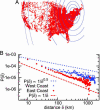Geographic routing in social networks
- PMID: 16081538
- PMCID: PMC1187977
- DOI: 10.1073/pnas.0503018102
Geographic routing in social networks
Abstract
We live in a "small world," where two arbitrary people are likely connected by a short chain of intermediate friends. With scant information about a target individual, people can successively forward a message along such a chain. Experimental studies have verified this property in real social networks, and theoretical models have been advanced to explain it. However, existing theoretical models have not been shown to capture behavior in real-world social networks. Here, we introduce a richer model relating geography and social-network friendship, in which the probability of befriending a particular person is inversely proportional to the number of closer people. In a large social network, we show that one-third of the friendships are independent of geography and the remainder exhibit the proposed relationship. Further, we prove analytically that short chains can be discovered in every network exhibiting the relationship.
Figures






References
-
- Milgram, S. (1967) Psychol. Today 1, 61–67.
-
- Travers, J. & Milgram, S. (1969) Sociometry 32, 425–443.
-
- Korte, C. & Milgram, S. (1970) J. Pers. Soc. Psychol. 15, 101–118.
-
- Killworth, P. & Bernard, H. (1978) Soc. Networks 1, 159–192.
-
- Adamic, L. A., Lukose, R. M., Puniyani, A. R. & Huberman, B. A. (2001) Phys. Rev. E 64, 046135. - PubMed
MeSH terms
LinkOut - more resources
Full Text Sources
Other Literature Sources

